Overview
This blog is the first in a series of blogs in which we are going to look at the disk layout of the ext4 filesystem. We will be looking at different types of on-disk structures in newly created ext4 filesystems and understand their importantance.
To create an ext4 filesystem on a device, let’s say the device be sdb1, run the following command:
mkfs.ext4 /dev/sdb1
The mkfs.ext4 creates an ext4 filesystem on device sdb1. mkfs.ext4 can take many arguments which facilitate the specification and customizaton of ext4 features. We can either enable or disable a feature depending upon our specific requirements. The default values for ext4 features for newly created ext4 filesystems is contained in the configuration file /etc/mke2fs.conf. These default feature values can be overridden by specifying command line arguments to mkfs.ext4.
Lets take a look at the contents of /etc/mke2fs.conf:
[defaults]
base_features = sparse_super,large_file,filetype,resize_inode,dir_index,ext_attr
default_mntopts = acl,user_xattr
enable_periodic_fsck = 0
blocksize = 4096
inode_size = 256
inode_ratio = 16384
[fs_types]
...
ext4 = {
features = has_journal,extent,huge_file,flex_bg,metadata_csum,64bit,dir_nlink,extra_isize
inode_size = 256
}
...
Note: Only contents related to ext4 filesystem are displayed.
The configuration settings for base_features and features are enabled by default. If we want to disable any of these or enable any other feature, we can do so using mkfs.ext4. Some other default settings of interest might be that periodic fsck is disabled, the default blocksize being set to 4096 bytes, the inode size is 256 bytes and the inode_ratio is 16384.
Knowing the default values of blocksize, inode_size and inode_ratio is important because these parameters decide the number of blocks, the number of block groups and the number of inodes in a filesystem. As already mentioned, these values can be changed with mkfs.ext4. Among these, blocksize and inode_size are self explanatory, however inode_ratio needs some explanation.
inode_ratio: This gives the number of bytes for which, an inode is created. That means an inode is created for every inode_ratio bytes.
In our case, we have inode_ratio = 16384, so mkfs.ext4 creates a inode for every 16384 bytes. If we run mkfs.ext4 on a 1GiB device, it creates 65536 inodes in the filesystem – as 1Gib/16364bytes = 65536. Therefore, the number of inodes in a filesystem is given by (filesystem size)/(inode_ratio).
Layout
The following are important on-disk structures of an ext4 filesystem: – Superblock – Block Group Descriptor, Group Descriptor Table – Inode Bitmap – Block Bitmap – Inode Table – Extent Tree – Hash Tree – Journal
In this blog, we will cover up to the Inode Table, the rest will be covered in subsequent blogs.
An ext4 filesystem is divided into block groups. Each block group has 8*blocksize (in bytes) number of blocks in it. If we consider the default blocksize, which is 4096 bytes, the number of blocks in blockgroup is given by 8*4096 = 32768 blocks in each group.
Size of each block group = (Number of blocks in each group) * blocksize
The number of block groups can be obtained by dividing the filesystem size by the size of each block group. (filesystem size)/(size of each block group).
Generally the default block size is 4KiB, using the above formulae the number of blocks in each block group will be 32768 and the block group size will be of length 128MiB. For a 1GiB filesystem we will have 8 (1 GiB/128 MiB) block groups.
Each block group has its associated block group descriptor, block bitmap, inode bitmap and inode table.
So, a filesystem with 8 block groups has 8 block group descriptors, 8 block bitmaps, 8 inode bitmaps and 8 inode tables.
Block group descriptors for all groups together is called the Group Descriptor Table (GDT).
No. of inodes in each group = (Total Number of Inodes) / (No. block groups)
Inode Table Size = No. of Inodes in each Group * inode_size
Note: For simplicity, we have used 1 GiB filesystem with blocksize = 4096, inode_size = 256, inode_ratio = 16384 as an example through out the document.
Graphical view of Disk Layout
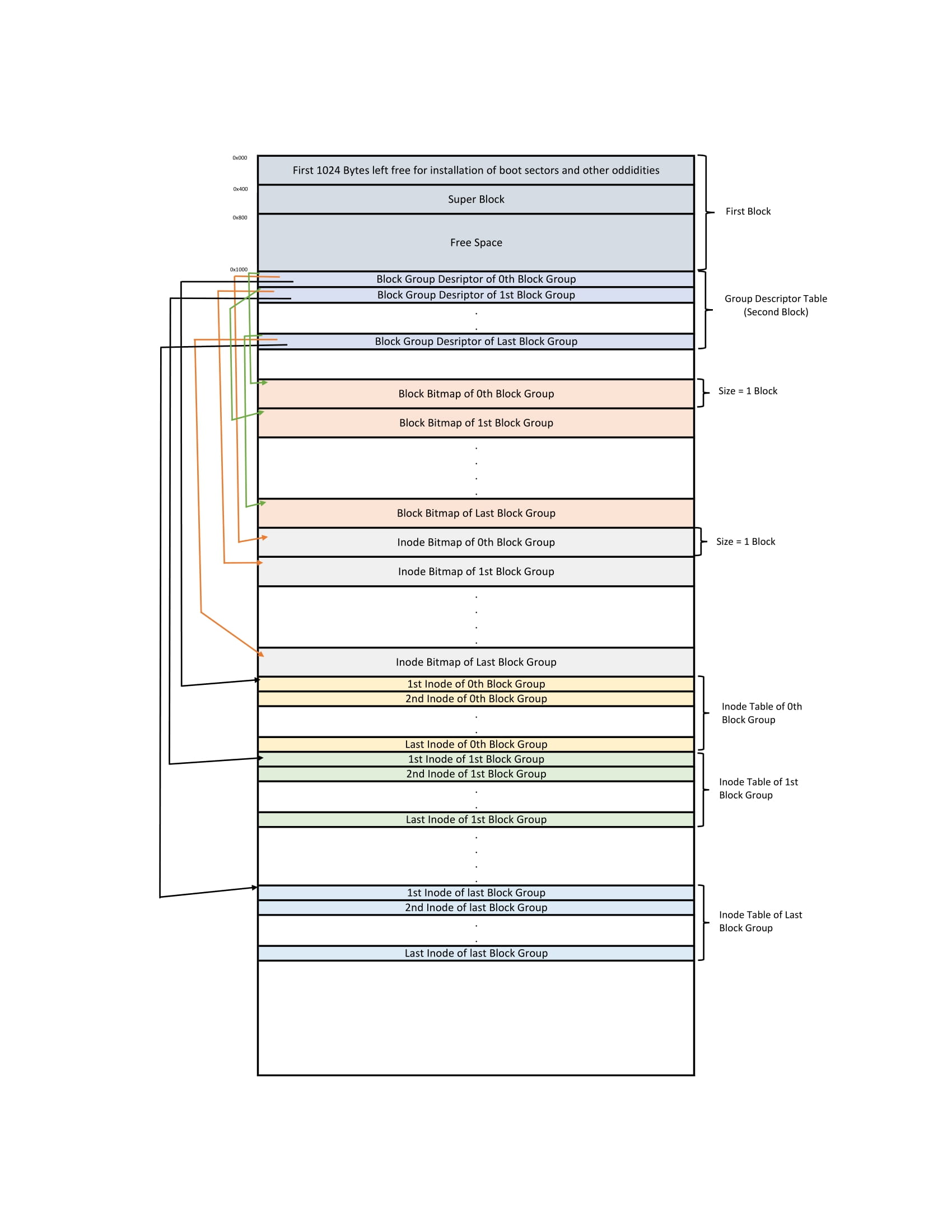
Note: When flex groups are used (see below for more info), the metadata of the entire flex group is contained in the first block group of the flex group. In the above example the filesystem has only 1 flex group. So, the metadata of all block groups are contained in only the first block group.
Superblock
On an ext4 filesystem, the first block contains the Superblock. struct ext4_super_block is the on-disk structure of the Superblock. The size of struct ext4_super_block is 1024 Bytes. In the first block of the filesystem, the first 1024 bytes are left for the installation of boot sectors and other oddities. And the next 1024 bytes are used for the Superblock. the remaining 2048 bytes in first block remain unused.
On disk ext4 Superblock structure
struct ext4_super_block {
/*00*/ __le32 s_inodes_count; /* Inodes count */
__le32 s_blocks_count_lo; /* Blocks count */
__le32 s_r_blocks_count_lo; /* Reserved blocks count */
__le32 s_free_blocks_count_lo; /* Free blocks count */
/*10*/ __le32 s_free_inodes_count; /* Free inodes count */
__le32 s_first_data_block; /* First Data Block */
__le32 s_log_block_size; /* Block size */
__le32 s_log_cluster_size; /* Allocation cluster size */
/*20*/ __le32 s_blocks_per_group; /* # Blocks per group */
__le32 s_clusters_per_group; /* # Clusters per group */
__le32 s_inodes_per_group; /* # Inodes per group */
__le32 s_mtime; /* Mount time */
/*30*/ __le32 s_wtime; /* Write time */
__le16 s_mnt_count; /* Mount count */
__le16 s_max_mnt_count; /* Maximal mount count */
__le16 s_magic; /* Magic signature */
__le16 s_state; /* File system state */
__le16 s_errors; /* Behaviour when detecting errors */
__le16 s_minor_rev_level; /* minor revision level */
/*40*/ __le32 s_lastcheck; /* time of last check */
__le32 s_checkinterval; /* max. time between checks */
__le32 s_creator_os; /* OS */
__le32 s_rev_level; /* Revision level */
/*50*/ __le16 s_def_resuid; /* Default uid for reserved blocks */
__le16 s_def_resgid; /* Default gid for reserved blocks */
/*
* These fields are for EXT4_DYNAMIC_REV Superblocks only.
*
* Note: the difference between the compatible feature set and
* the incompatible feature set is that if there is a bit set
* in the incompatible feature set that the kernel doesn't
* know about, it should refuse to mount the filesystem.
*
* e2fsck's requirements are more strict; if it doesn't know
* about a feature in either the compatible or incompatible
* feature set, it must abort and not try to meddle with
* things it doesn't understand...
*/
__le32 s_first_ino; /* First non-reserved inode */
__le16 s_inode_size; /* size of inode structure */
__le16 s_block_group_nr; /* block group # of this Superblock */
__le32 s_feature_compat; /* compatible feature set */
/*60*/ __le32 s_feature_incompat; /* incompatible feature set */
__le32 s_feature_ro_compat; /* readonly-compatible feature set */
/*68*/ __u8 s_uuid[16]; /* 128-bit uuid for volume */
/*78*/ char s_volume_name[16]; /* volume name */
/*88*/ char s_last_mounted[64] __nonstring; /* directory where last mounted */
/*C8*/ __le32 s_algorithm_usage_bitmap; /* For compression */
/*
* Performance hints. Directory preallocation should only
* happen if the EXT4_FEATURE_COMPAT_DIR_PREALLOC flag is on.
*/
__u8 s_prealloc_blocks; /* Nr of blocks to try to preallocate*/
__u8 s_prealloc_dir_blocks; /* Nr to preallocate for dirs */
__le16 s_reserved_gdt_blocks; /* Per group desc for online growth */
/*
* Journaling support valid if EXT4_FEATURE_COMPAT_HAS_JOURNAL set.
*/
/*D0*/ __u8 s_journal_uuid[16]; /* uuid of journal Superblock */
/*E0*/ __le32 s_journal_inum; /* inode number of journal file */
__le32 s_journal_dev; /* device number of journal file */
__le32 s_last_orphan; /* start of list of inodes to delete */
__le32 s_hash_seed[4]; /* HTREE hash seed */
__u8 s_def_hash_version; /* Default hash version to use */
__u8 s_jnl_backup_type;
__le16 s_desc_size; /* size of group descriptor */
/*100*/ __le32 s_default_mount_opts;
__le32 s_first_meta_bg; /* First metablock block group */
__le32 s_mkfs_time; /* When the filesystem was created */
__le32 s_jnl_blocks[17]; /* Backup of the journal inode */
/* 64bit support valid if EXT4_FEATURE_COMPAT_64BIT */
/*150*/ __le32 s_blocks_count_hi; /* Blocks count */
__le32 s_r_blocks_count_hi; /* Reserved blocks count */
__le32 s_free_blocks_count_hi; /* Free blocks count */
__le16 s_min_extra_isize; /* All inodes have at least # bytes */
__le16 s_want_extra_isize; /* New inodes should reserve # bytes */
__le32 s_flags; /* Miscellaneous flags */
__le16 s_raid_stride; /* RAID stride */
__le16 s_mmp_update_interval; /* # seconds to wait in MMP checking */
__le64 s_mmp_block; /* Block for multi-mount protection */
__le32 s_raid_stripe_width; /* blocks on all data disks (N*stride)*/
__u8 s_log_groups_per_flex; /* FLEX_BG group size */
__u8 s_checksum_type; /* metadata checksum algorithm used */
__u8 s_encryption_level; /* versioning level for encryption */
__u8 s_reserved_pad; /* Padding to next 32bits */
__le64 s_kbytes_written; /* nr of lifetime kilobytes written */
__le32 s_snapshot_inum; /* Inode number of active snapshot */
__le32 s_snapshot_id; /* sequential ID of active snapshot */
__le64 s_snapshot_r_blocks_count; /* reserved blocks for active
snapshot's future use */
__le32 s_snapshot_list; /* inode number of the head of the
on-disk snapshot list */
#define EXT4_S_ERR_START offsetof(struct ext4_super_block, s_error_count)
__le32 s_error_count; /* number of fs errors */
__le32 s_first_error_time; /* first time an error happened */
__le32 s_first_error_ino; /* inode involved in first error */
__le64 s_first_error_block; /* block involved of first error */
__u8 s_first_error_func[32] __nonstring; /* function where the error happened */
__le32 s_first_error_line; /* line number where error happened */
__le32 s_last_error_time; /* most recent time of an error */
__le32 s_last_error_ino; /* inode involved in last error */
__le32 s_last_error_line; /* line number where error happened */
__le64 s_last_error_block; /* block involved of last error */
__u8 s_last_error_func[32] __nonstring; /* function where the error happened */
#define EXT4_S_ERR_END offsetof(struct ext4_super_block, s_mount_opts)
__u8 s_mount_opts[64];
__le32 s_usr_quota_inum; /* inode for tracking user quota */
__le32 s_grp_quota_inum; /* inode for tracking group quota */
__le32 s_overhead_clusters; /* overhead blocks/clusters in fs */
__le32 s_backup_bgs[2]; /* groups with sparse_super2 SBs */
__u8 s_encrypt_algos[4]; /* Encryption algorithms in use */
__u8 s_encrypt_pw_salt[16]; /* Salt used for string2key algorithm */
__le32 s_lpf_ino; /* Location of the lost+found inode */
__le32 s_prj_quota_inum; /* inode for tracking project quota */
__le32 s_checksum_seed; /* crc32c(uuid) if csum_seed set */
__u8 s_wtime_hi;
__u8 s_mtime_hi;
__u8 s_mkfs_time_hi;
__u8 s_lastcheck_hi;
__u8 s_first_error_time_hi;
__u8 s_last_error_time_hi;
__u8 s_pad[2];
__le16 s_encoding; /* Filename charset encoding */
__le16 s_encoding_flags; /* Filename charset encoding flags */
__le32 s_reserved[95]; /* Padding to the end of the block */
__le32 s_checksum; /* crc32c(Superblock) */
};
Byte level view of an Ext4 Superblock
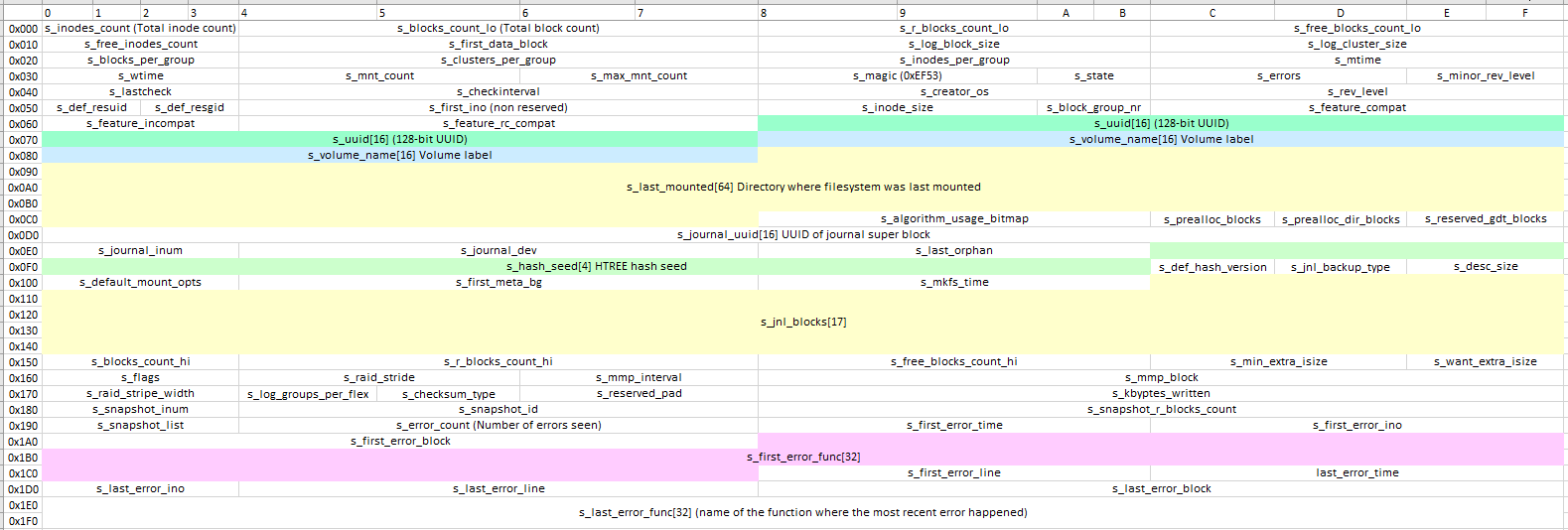
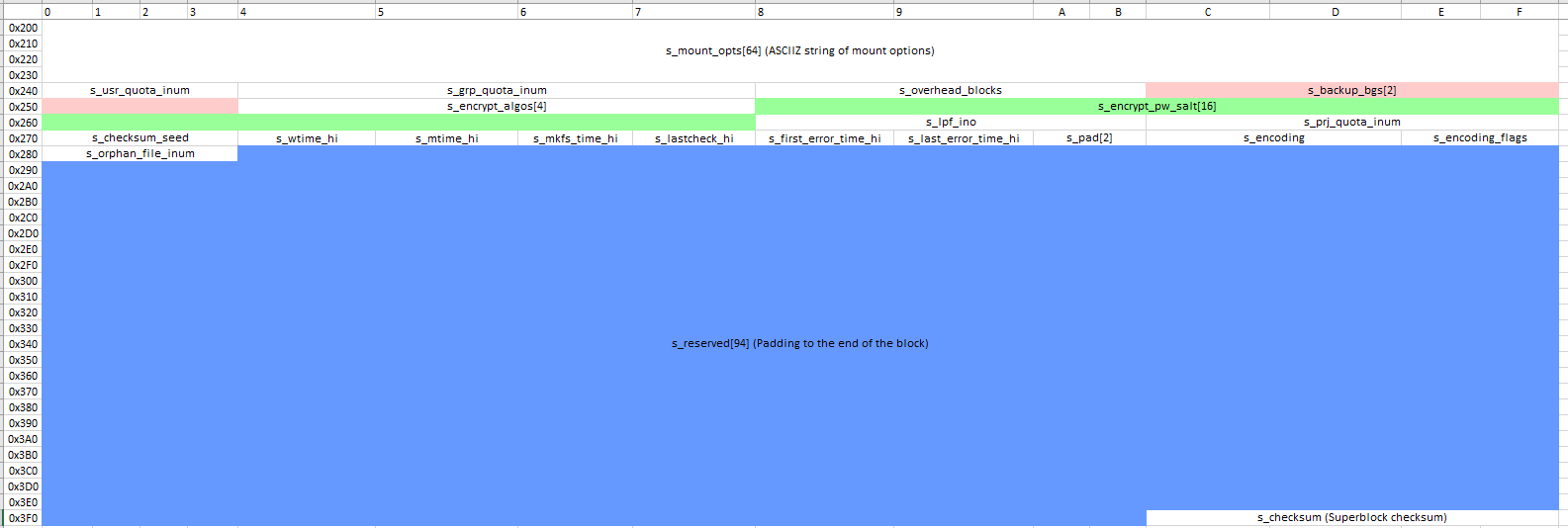
Superblock state (0x03A to 0x03B): * 0001 – Cleanly umounted (This is the case in above hexdump) * 0002 – Errors detected * 0004 – Orphans being recovered
Filesystem creator OS (0x048 to 0x049) * 0 – Linux (Linux the creator OS in the above hexdump) * 1 – Hurd * 2 – Masix * 3 – FreeBSD * 4 – Lites
Superblock encrypt algorithms (0x254 to 0x257) * 0 – Invalid Algorithm (ENCRYPTION_MODE_INVALID) * 1 – 256-bit in XTS mode (ENCRYPTION_MODE_AES_256_XTS) * 2 – 256-bit AES in GCM mode (ENCRYPTION_MODE_AES_256_GCM) * 3 – 256-bit AES in CBC mode (ENCRYPTION_MODE_AES_256_CBC)
Superblock Hexdump
Note: Ext4 uses little endian notation.
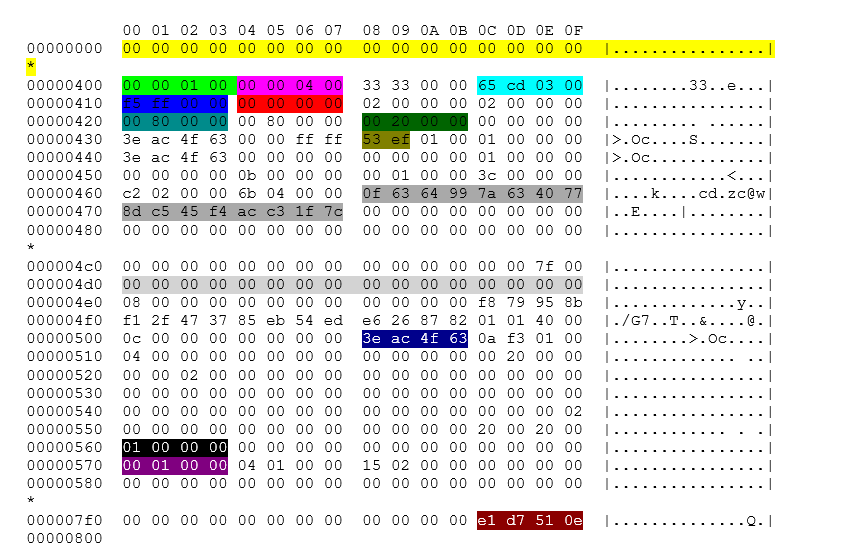
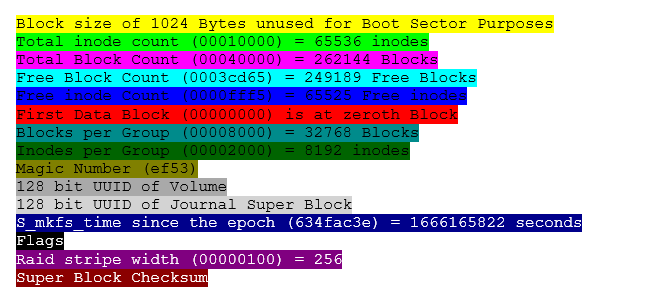
A few important fields of the Superblock are highlighted in the hexdump. The total size of the Superblock is 1024 bytes, which spans from 0000400 to 00007ff.
Endianness: Ext4 uses little endian notation. In little endian notation the rightmost byte will be the most significant byte.
For Example, from the above hexdump image, if we observe the magic number in the hexdump is 53 ef, but the actual magic number of an ext4 filesystem is 0xef53. As ext4 uses little endian, the most significant byte will be the right most byte. So, ef is most significant byte and 53 is least significant byte.
Primary and Backup Superblocks Backup copies of the Superblock are written to some of the block groups across the disk – in case the beginning of the disk gets trashed, backup Superblocks can be used for recovery. Not all blocks groups will have a Superblock copy. In our case (1GiB ext4 filesystem) apart from the primary Superblock, other copies are present in the first, third, fifth and seventh block groups. The 0th block group will host the primary Superblock.
The Superblock contains a lot of information regarding the filesystem, so if the primary Superblock gets corrupted then vital information pertaining to the filesystem is compromised. To overcome such situations, backup Superblocks are stored at different places in the filesystem.
In earlier versions such as ext2, backup Superblocks were created in every block group. But the ext4 filesystem has a sparse_super feature, which when enabled results in backup Superblocks only being created in blockgroups 0, 1 and powers of 3, 5 and 7 (e.g. powers of 3 = 9, 27, 81 …..; powers of 5 = 25, 125, 625 ….; powers of 7 = 49, 343, 2401 …).
Backup Superblocks and backup GDTs are never updated by the kernel. They will get updated only if any fundamental parameter of the filesystem is amended, for example, resizing the filesystem. Programs like resize2fs and tune2fs will change structural parameters and cause updates to the backup Superblocks and GDTs.
Block Group Descriptors
A block group is a logical grouping of contigous blocks, whose size is equal to the number of bits in one block. For example, in a filesystem with a blocksize of 4096 bytes, a block group will have 4096*8 = 32768 blocks. Each block group is represented by its block group descriptor, which stores information such as free inodes, free blocks and the location of the block bitmap, inode bitmap and the inode table of that particular block group.
The Group Descriptor Table (GDT) contains all block group descriptors, we can call the GDT a table of block group descriptors of all block groups of the filesystem.
The GDT will be present immediately after the Superblock block, and backup copies of the GDT are stored similarly to the backup copies of the Superblock. If sparse_super is set then just like Superblock backups, GDT backups will be in block groups 0, 1 and powers of 3, 5, 7 (e.g. 27, 125, 343 etc), if sparse_super is not set, then these backup copies will be present in all block groups.
GDTs will follow Superblocks, the primary GDT will be present in second block. Each block group descriptor is of 64 Bytes, so for a filesystem with 8 block groups there will be a group decriptor table occupying 512 Bytes (8*64) in the second block, and the remaining block will be unused.
On disk block group descriptor is represented by struct ext4_group_desc
/*
* Structure of a blocks group descriptor
*/
struct ext4_group_desc
{
__le32 bg_block_bitmap_lo; /* Blocks bitmap block */
__le32 bg_inode_bitmap_lo; /* Inodes bitmap block */
__le32 bg_inode_table_lo; /* Inodes table block */
__le16 bg_free_blocks_count_lo;/* Free blocks count */
__le16 bg_free_inodes_count_lo;/* Free inodes count */
__le16 bg_used_dirs_count_lo; /* Directories count */
__le16 bg_flags; /* EXT4_BG_flags (INODE_UNINIT, etc) */
__le32 bg_exclude_bitmap_lo; /* Exclude bitmap for snapshots */
__le16 bg_block_bitmap_csum_lo;/* crc32c(s_uuid+grp_num+bbitmap) LE */
__le16 bg_inode_bitmap_csum_lo;/* crc32c(s_uuid+grp_num+ibitmap) LE */
__le16 bg_itable_unused_lo; /* Unused inodes count */
__le16 bg_checksum; /* crc16(sb_uuid+group+desc) */
__le32 bg_block_bitmap_hi; /* Blocks bitmap block MSB */
__le32 bg_inode_bitmap_hi; /* Inodes bitmap block MSB */
__le32 bg_inode_table_hi; /* Inodes table block MSB */
__le16 bg_free_blocks_count_hi;/* Free blocks count MSB */
__le16 bg_free_inodes_count_hi;/* Free inodes count MSB */
__le16 bg_used_dirs_count_hi; /* Directories count MSB */
__le16 bg_itable_unused_hi; /* Unused inodes count MSB */
__le32 bg_exclude_bitmap_hi; /* Exclude bitmap block MSB */
__le16 bg_block_bitmap_csum_hi;/* crc32c(s_uuid+grp_num+bbitmap) BE */
__le16 bg_inode_bitmap_csum_hi;/* crc32c(s_uuid+grp_num+ibitmap) BE */
__u32 bg_reserved;
};
Byte level view of block group descriptor

Hexdump of a Group Descriptor Table
The following is a GDT hexdump of a newly created ext4 filesystem of 1GiB size. As the GDT follows the Superblock’s block, the GDT will start at 4096th byte (0x1000).
Filesystem’s block size is 4096 Bytes
No. of blocks in each block group = 8 * blocksize = 32768 blocks.
Size of each block group = no. of blocks * blocksize = 32768 * 4096 = 134,217,728 = 128MiB
No. of block groups = (Size of File System)/(Size of each block group) = 1GiB/128MiB = 8.
Therefore a GDT will have 8 block group descriptors in it.
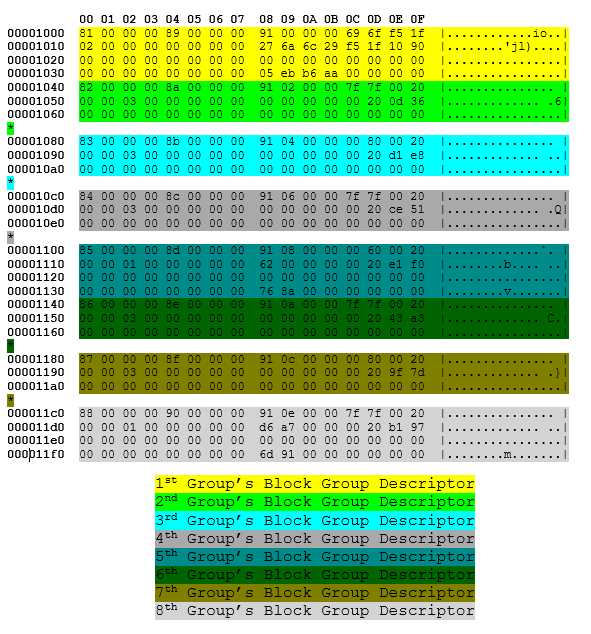
Hexdump of first group descriptor of explained:
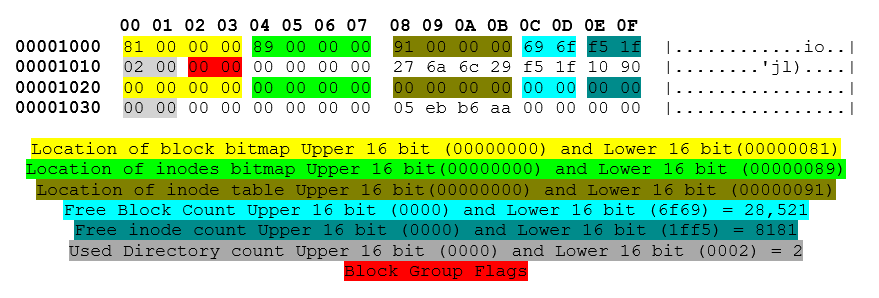
Block Bitmap
The Block bitmap tracks the block usage status of all blocks of a block group. Each bit in the bitmap represents a block. If a block is in use, its corresponding bit will be set, otherwise it will be unset. The location of the block bitmap is not fixed, so its position is stored in respective block group descriptors.
From the above image, the location of the block bitmap is given as 0x81 (129 in decimal). That means the block bitmap is at 129th block. As each block is 4096 bytes, the block bitmap will start at 528384th byte, which is 81000 in hex. Below is a hexdump from that offset. The size of the block bitmap is 1 block (4096 bytes here).
Hexdump of block bitmap
00081000 ff ff ff ff ff ff ff ff ff ff ff ff ff ff ff ff |................| * 00081210 ff ff 7f 00 00 00 00 00 00 00 00 00 00 00 00 00 |................| 00081220 00 00 00 00 00 00 00 00 00 00 00 00 00 00 00 00 |................| * 00082000 00 00 00 00 00 00 00 00 00 00 00 00 00 00 00 00 |................|
Inode Bitmap
Similar to the Block bitmap, the Inode bitmap’s location is also not fixed, therefore the group descriptor points to the location of the Inode bitmap. The Inode bitmap tracks usage of inodes. Each bit in the bitmap represents an inode. If an inode is in use then its corresponding bit in Inode bitmap will be set, otherwise it will be unset.
Each Inode bitmap uses a block. As in this case we have only 8192 inodes in each group, only the first 1024 bytes are used as a bitmap. From the above hexdump of a block group descriptor, the location of the inode bitmap is given as 0x00000089 (137 in decimal). Therefore the inode bitmap is present at 137th block. As each block is 4096 bytes, the offset of the 137th block is 0x89000 (137 * 4096). Below is the hexdump of an inode bitmap at that offset.
Hexdump of inode bitmap
00089000 ff 07 00 00 00 00 00 00 00 00 00 00 00 00 00 00 |................| 00089010 00 00 00 00 00 00 00 00 00 00 00 00 00 00 00 00 |................| * 00089400 ff ff ff ff ff ff ff ff ff ff ff ff ff ff ff ff |................| * 0008a000 00 00 00 00 00 00 00 00 00 00 00 00 00 00 00 00 |................|
From the above hexdump, we can see that starting from 0x00089400 every bit is set until 0x0008a000 because only the first 1024 bytes are used as a bitmap, these remaining bits are not part of bitmap.
Inode Table
The Inode Table is a table of all the inodes in a block group. In our example, the inode size is 256 bytes, and there has to be one inode for every 16384 bytes (inode_ratio). For a filesystem of 1 GiB, having 8 block groups, the total number of inodes will be 65536 (1Gib/16Kib = 65536), and 8192 inodes per block group (65536/8 = 8192). The size of the inode table will be 2Mib per block group (256*8192=2097152 = 2MiB). For 8 block groups, a space of 16 Mib is required for all inode tables, and 4096 blocks are used for this purpose (16MiB/4Kib).
The location of the inode table as given by the block group descriptor of the first block group is 0x00000091(145 in decimal). The offset of the 145th block is 0x00091000.
Hexdump of 1st inode in inode table
00091000 00 00 00 00 00 00 00 00 8a 45 7b 63 8a 45 7b 63 |.........E{c.E{c|
00091010 8a 45 7b 63 00 00 00 00 00 00 00 00 00 00 00 00 |.E{c............|
00091020 00 00 00 00 00 00 00 00 00 00 00 00 00 00 00 00 |................|
*
00091070 00 00 00 00 00 00 00 00 00 00 00 00 df 46 00 00 |.............F..|
00091080 00 00 00 00 00 00 00 00 00 00 00 00 00 00 00 00 |................|
*
00091100 ed 41 00 00 00 b0 1d 00 45 14 93 63 18 14 93 63 |.A......E..c...c|
Inode Structure
struct ext4_inode {
__le16 i_mode; /* File mode */
__le16 i_uid; /* Low 16 bits of Owner Uid */
__le32 i_size_lo; /* Size in bytes */
__le32 i_atime; /* Access time */
__le32 i_ctime; /* Inode Change time */
__le32 i_mtime; /* Modification time */
__le32 i_dtime; /* Deletion Time */
__le16 i_gid; /* Low 16 bits of Group Id */
__le16 i_links_count; /* Links count */
__le32 i_blocks_lo; /* Blocks count */
__le32 i_flags; /* File flags */
union {
struct {
__le32 l_i_version;
} linux1;
struct {
__u32 h_i_translator;
} hurd1;
struct {
__u32 m_i_reserved1;
} masix1;
} osd1; /* OS dependent 1 */
__le32 i_block[EXT4_N_BLOCKS];/* Pointers to blocks */
__le32 i_generation; /* File version (for NFS) */
__le32 i_file_acl_lo; /* File ACL */
__le32 i_size_high;
__le32 i_obso_faddr; /* Obsoleted fragment address */
union {
struct {
__le16 l_i_blocks_high; /* were l_i_reserved1 */
__le16 l_i_file_acl_high;
__le16 l_i_uid_high; /* these 2 fields */
__le16 l_i_gid_high; /* were reserved2[0] */
__le16 l_i_checksum_lo;/* crc32c(uuid+inum+inode) LE */
__le16 l_i_reserved;
} linux2;
struct {
__le16 h_i_reserved1; /* Obsoleted fragment number/size which are removed in ext4 */
__u16 h_i_mode_high;
__u16 h_i_uid_high;
__u16 h_i_gid_high;
__u32 h_i_author;
} hurd2;
struct {
__le16 h_i_reserved1; /* Obsoleted fragment number/size which are removed in ext4 */
__le16 m_i_file_acl_high;
__u32 m_i_reserved2[2];
} masix2;
} osd2; /* OS dependent 2 */
__le16 i_extra_isize;
__le16 i_checksum_hi; /* crc32c(uuid+inum+inode) BE */
__le32 i_ctime_extra; /* extra Change time (nsec << 2 | epoch) */
__le32 i_mtime_extra; /* extra Modification time(nsec << 2 | epoch) */
__le32 i_atime_extra; /* extra Access time (nsec << 2 | epoch) */
__le32 i_crtime; /* File Creation time */
__le32 i_crtime_extra; /* extra FileCreationtime (nsec << 2 | epoch) */
__le32 i_version_hi; /* high 32 bits for 64-bit version */
__le32 i_projid; /* Project ID */
};
Byte level view of on disk inode

Inode hexdump
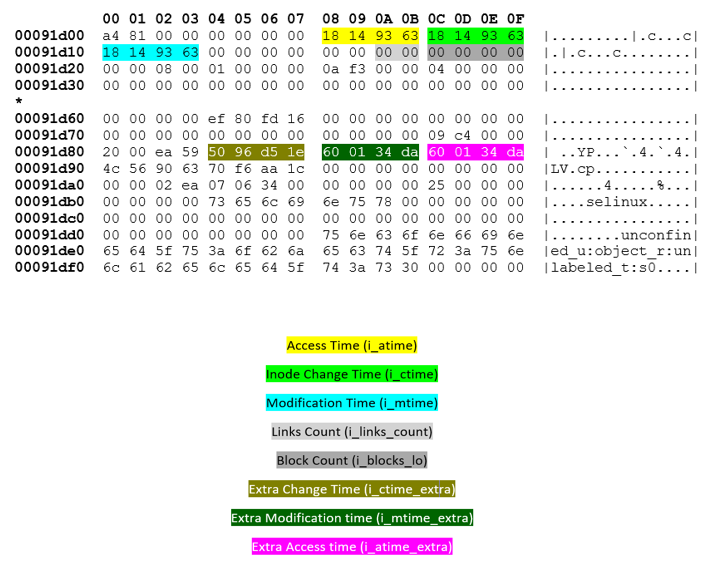
Above is the hexdump of the fourteenth inode in the inode table. The size of the on-disk inode structure struct ext4_inode is 160 bytes. The extra 96 bytes at the end are used to store the extended attributes.
From the above hexdump access time (i_atime) is 0x63931418 which is 1,670,583,320 in decimal. The following is stat output for the same inode.

If we convert our time stamp from hexdump to a readable date format, we see that it will match with the access time from the stat image.

Flex Block Groups
In ext4 filesystems, we have a feature called flex_bg. If this feature is enabled, then the number of block groups given by 2^s_log_groups_per_flex (s_log_groups_per_flex is a Superblock field) are grouped as a single flex group and the inode bitmaps, block bitmaps, and inode tables of all the groups in flex group are stored in the first block group of the flex group.
For example, if s_log_groups_per_flex is 4 then the size of flex group is 16 (2^4) and assume that the filesystem has 48 block groups in toteal. In this case, the filesystem will have 3 flex groups, each containing 16 block groups. All the inode bitmaps, block bitmaps and inode tables of all the groups of the first flext group (0-15 block groups), second flex group (16-31 block groups), and the last flext group (32-47 block groups) will be stored in 0th, 16th, and 32nd blockgroups respectively.
Note: This feature does not change the location of the backup Superblocks and backup GDTs.
Conclusion
On an ext4 filesystem, the on-disk data structures are present in the same order as discussed above. The Superblock, followed by the GDT, with the GDT pointing to the locations of corresponding block bitmaps, inode bitmaps and inode tables. When creating a filesystem, mkfs.ext4 creates some important structures, we have only covered up to inode tables in this blog, and future blogs will cover the rest of the data structures.
References
- e2fsprogs code – 1.46.6-rc1
- Kernel code- 5.4.17-2136.310.7.1.el8uek.x86_64
- https://www.kernel.org/doc/html/latest/filesystems/ext4/index.html
- https://www.spinics.net/lists/linux-ext4/msg62155.html